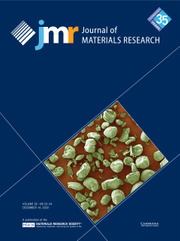Crossref Citations
This article has been cited by the following publications. This list is generated based on data provided by
Crossref.
Goodenough, J.B.
and
Manthiram, A.
1990.
Crystal chemistry and superconductivity of the copper oxides.
Journal of Solid State Chemistry,
Vol. 88,
Issue. 1,
p.
115.
Irwin, J. C.
Chrzanowski, J.
Altendorf, E.
Franck, J. P.
and
Jung, J.
1990.
A Raman investigation of isotope exchange in YBa2Cu3O7−x.
Journal of Materials Research,
Vol. 5,
Issue. 12,
p.
2780.
Frommer, M H
1990.
X-ray photoelectron study of the non-equivalent oxygen lattice sites in Y-Ba-Cu oxide thin films.
Superconductor Science and Technology,
Vol. 3,
Issue. 11,
p.
523.
Otamiri, J.C.
Andersson, S.L.T.
and
Andersson, A.
1990.
Ammoxidation of toluene by YBa2Cu3O6+x and copper oxides.
Applied Catalysis,
Vol. 65,
Issue. 1,
p.
159.
Manthiram, A.
Tang, X. X.
and
Goodenough, J. B.
1990.
c-axis oxygen in copper oxide superconductors.
Physical Review B,
Vol. 42,
Issue. 1,
p.
138.
Ramli, Emannuel
Ganja, Edward A.
Reven, Linda
Oldfield, Eric
and
Rauchfuss, Thomas B.
1990.
An 17O NMR study on oxygen exchange in YBa2Cu3O7−x.
Journal of Solid State Chemistry,
Vol. 86,
Issue. 2,
p.
279.
Frank, J.P.
Jung, J.
Salomons, G.
Miner, W.A.
Mohamed, M.A.-K.
Chrzanowski, J.
Gygax, S.
Irwin, J.C.
Mitchell, D.F.
and
Sproule, G.I.
1990.
The oxygen isotope effect in superconducting YBa2Cu3O7−δ.
Physica C: Superconductivity,
Vol. 172,
Issue. 1-2,
p.
90.
Altendorf, E.
Chrzanowski, J.
Irwin, J. C.
and
Franck, J. P.
1991.
Modeling oxygen isotope shifts and line-broadening effects of the 502-cm−1Raman mode ofYBa2Cu3O7−x.
Physical Review B,
Vol. 43,
Issue. 4,
p.
2771.
Chrzanowski, J
Altendorf, E
Irwin, J C
Franck, J P
and
Jung, J
1991.
Oxygen isotope shifts of the Raman modes of YBa2Cu3O7−x.
Bulletin of Materials Science,
Vol. 14,
Issue. 3,
p.
551.
Rothman, S. J.
Routbort, J. L.
Welp, U.
and
Baker, J. E.
1991.
Anisotropy of oxygen tracer diffusion in single-crystalYBa2Cu3O7−δ.
Physical Review B,
Vol. 44,
Issue. 5,
p.
2326.
Thomsen, C.
Litvinchuk, A.
Scho¨nherr, E.
and
Cardona, M.
1992.
Chain-oxygen vibrations in YBa2Cu3O7-δ and YBa2Cu4O8.
Physical Review B,
Vol. 45,
Issue. 14,
p.
8154.
Smith, M. G.
Goodenough, J. B.
Manthiram, A.
Taylor, R. D.
and
Oesterreicher, H.
1992.
Effect of annealing on the local microstructure andTcinY1−zCazBa2(Cu0.90Co0.10)3O6+y.
Physical Review B,
Vol. 46,
Issue. 5,
p.
3041.
Zhang, X.
and
Catlow, C. R. A.
1992.
Molecular-dynamics study of oxygen diffusion inYBa2Cu3O6.91.
Physical Review B,
Vol. 46,
Issue. 1,
p.
457.
Islam, M. Saiful
and
Baetzold, Roger C.
1994.
Atomistic mechanisms of oxygen diffusion in YBa2Cu3O7 –xand YBa2Cu4O8.
J. Mater. Chem.,
Vol. 4,
Issue. 2,
p.
299.
Litvinchuk, A. P.
Thomsen, C.
and
Cardona, M.
1994.
Physical Properties of High Temperature Superconductors IV.
p.
375.
Zhang, X.
and
Catlow, C. R. A.
1994.
Molecular Dynamics Simulation of High-Tc Superconductors.
Molecular Simulation,
Vol. 12,
Issue. 2,
p.
115.
Zhao, Guo-meng
Keller, H
and
Conder, K
2001.
Unconventional isotope effects in the high-temperature cuprate superconductors.
Journal of Physics: Condensed Matter,
Vol. 13,
Issue. 29,
p.
R569.

